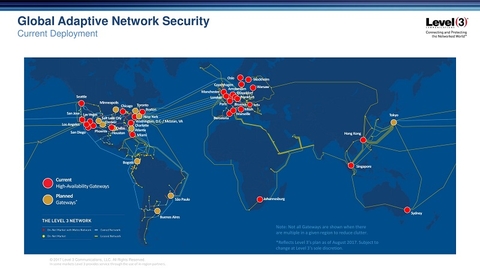Level 3 is expanding the availability of its cloud-based Adaptive Network Security footprint to new regions and adding additional gateways, enabling more of its customers to free themselves from managing on-premises network security platforms.
Adaptive Network Security is a cloud-based security solution that combines next-gen firewalling capabilities—including intrusion defense systems and intrusion protection systems, antimalware sandboxing, data loss protection, URL and web content filtering and application awareness and control—to allow customers to bring their own bandwidth to support various hybrid-networking scenarios.
Level 3 said that the cloud-based architecture of Adaptive Network Security enables enterprises to "future-proof" their security environments by breaking the hardware dependency cycle and allowing features and functions to be custom-configured depending on a customer’s specific needs.
RELATED: Level 3 applies its security expertise to its wavelength services line with encrypted service
“The whole idea is for customers to use Adaptive Network Security in place of on-premises firewalling equipment,” said Chris Richter, SVP of global security services for Level 3, in an interview with FierceTelecom. “The notion is if they connect IP sec or a Level 3 high-speed private network or some other high-speed internet connection, they can get the same perimeter protections benefits that they would otherwise be able to get from an on-premises firewall, but they don’t have any equipment to manage because everything is done on our cloud infrastructure.”
Existing and new customers will be able to access Adaptive Network Security through a constellation of security gateways distributed across Asia-Pacific, Europe, the Middle East and Africa and North America. These locations are all interconnected via Level 3’s global VPN backbone.
Richter said that the service provider continues to bring the service to more global locations by building out gateways in more locations to be more responsive to its customers’ security needs.
“The reason we’re building and expanding our gateways around the globe—including most recently in Singapore, Hong Kong, and Sydney—is so we get as close as possible to our core customer locations to minimize latency,” Richter said.
Richter added that if it’s not on premise, “we want to make sure it’s as close to the customer as possible.”
This new service will be able to accommodate Level 3’s customers who have operations in Asia-Pacific as well as those that are based in the region. Additionally, the service provider is expanding its reach in other markets including Eastern Europe and Africa.

“We’re going to expand the number of gateways well into 2018 as well as the function of those gateways,” Richter said.
Focus on hybrid networking
A key focus of Level 3’s Adaptive Network Security platform is flexibility.
By taking a carrier-agnostic approach to network solutions, Adaptive Network Security offers customers compatibility with, and uniform security coverage across, distributed hybrid networks, including everything from data centers and cloud deployments to branches, remote offices and mobile workers.The service can also support a customer’s adoption of SD-WAN, a service that Level 3 began offering earlier this year.
“Adaptive Network Security is designed to be adaptable to many flavors of SD-WAN,” Richter said. “It can act as the internet gateway, or the cloud-based interface, to different types of hybrid access.”
But what’s different about Level 3’s SD-WAN and Adaptive Network Security service is that it sits on Level 3’s own private network. While he could not provide specifics, Richter said that future releases will have more features focused on hybrid networking.
“Customers can access their private IP network from Level 3 or use it as a drain to the internet or both,” Richter said. “Based on the capabilities, we’re building a lot more routing features that can enhance the SD-WAN experience for customers.”
Visibility is also another feature of the new service. Through Level 3's customer portal, users can view their entire Adaptive Network Security ecosystem, enabling access to a multitude of reports and gateway performance metrics.
Custom migrations
Since no two customers are the same, Level 3 can provide an assessment and migration plan for customers that want to migrate to a cloud-based security platform via its professional services unit. With Level 3’s transformation methodology workshop, the service provider will counsel and consult with customers. This service capability can help a customer to migrate rules off their existing firewall platform to the Adaptive Security Network platform.
A retailer, for example, that has multiple locations may not have the on-site experience at each store to manage security, while a large global company may need its resources for other uses.
“Customers come in all shapes and sizes,” Ricther said. “Retailers may only need 30 Mbps of throughput, but outfits like that don’t have the security personnel, and then you have large megacompanies that use this service and they are resource-constrained.”
Richter said that the platform’s adaptable focus means that Level 3 can take on any size customer.
“One of the reasons why we say the service is adaptive is the service is priced based on the amount of throughput a customer is pushing through the gateway,” Richter said. “We can take on very small customers with low bandwidth requirements all the way up to customers that need multiple gigs of throughput with a number of locations around the globe.”